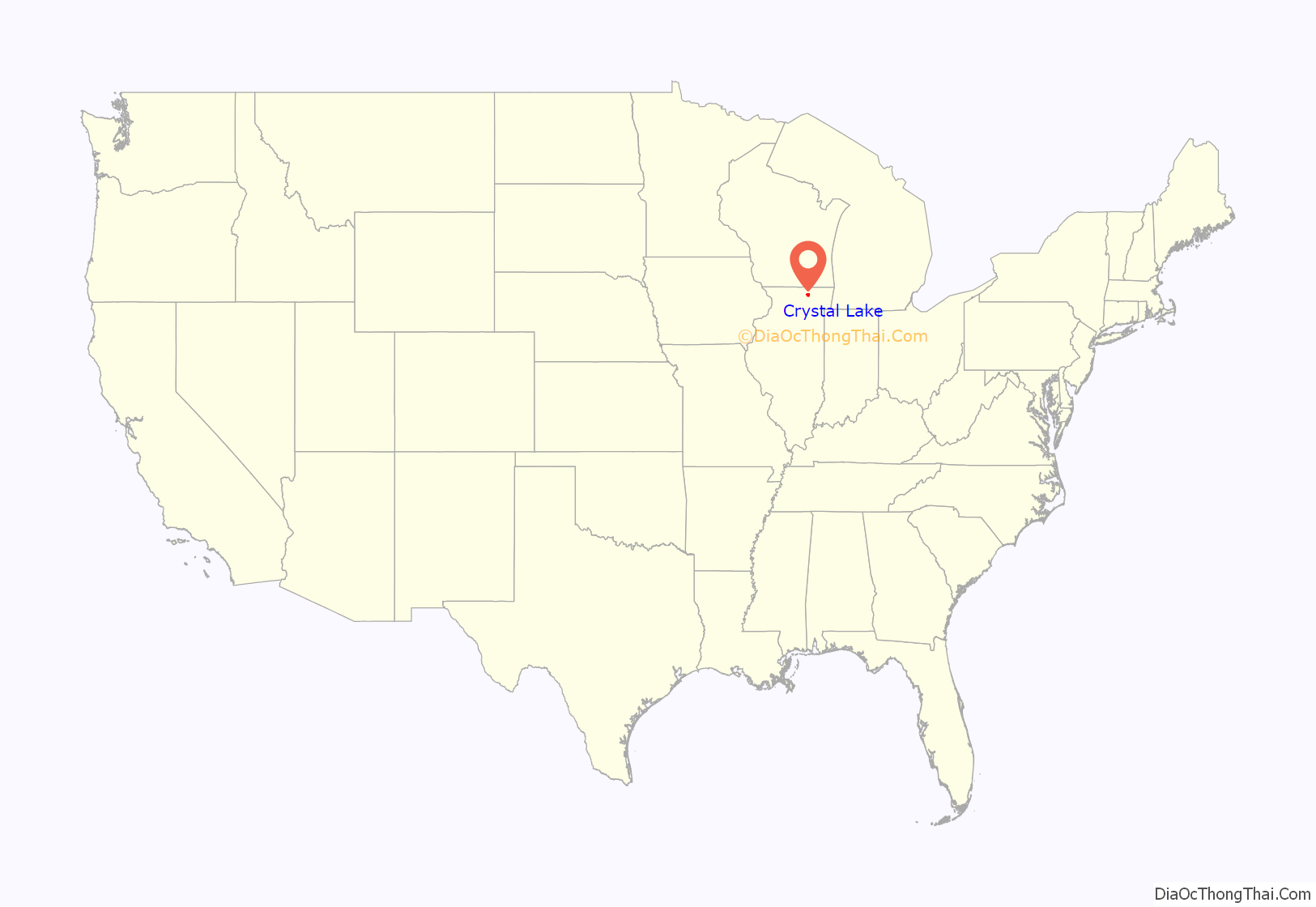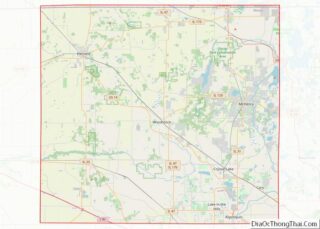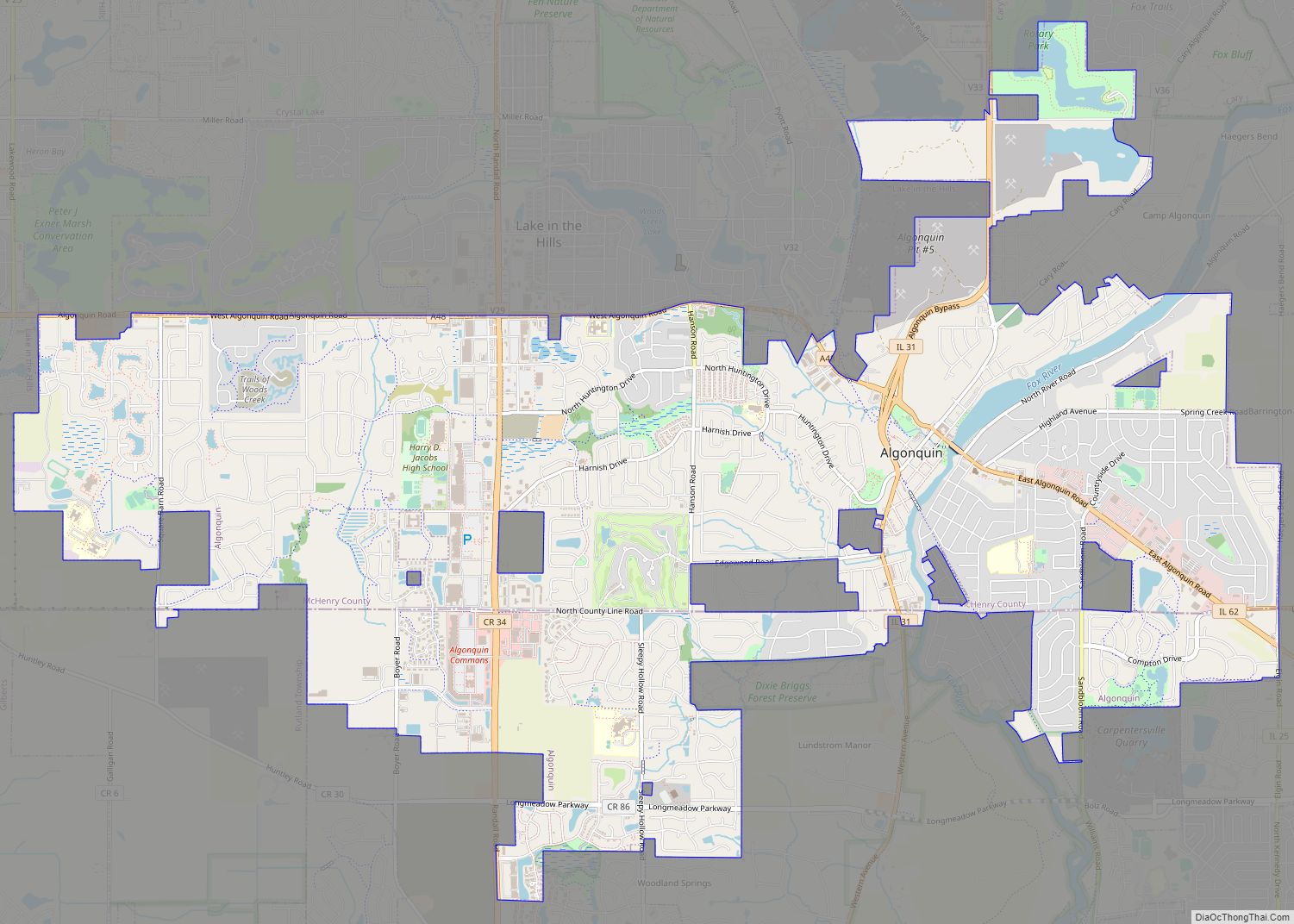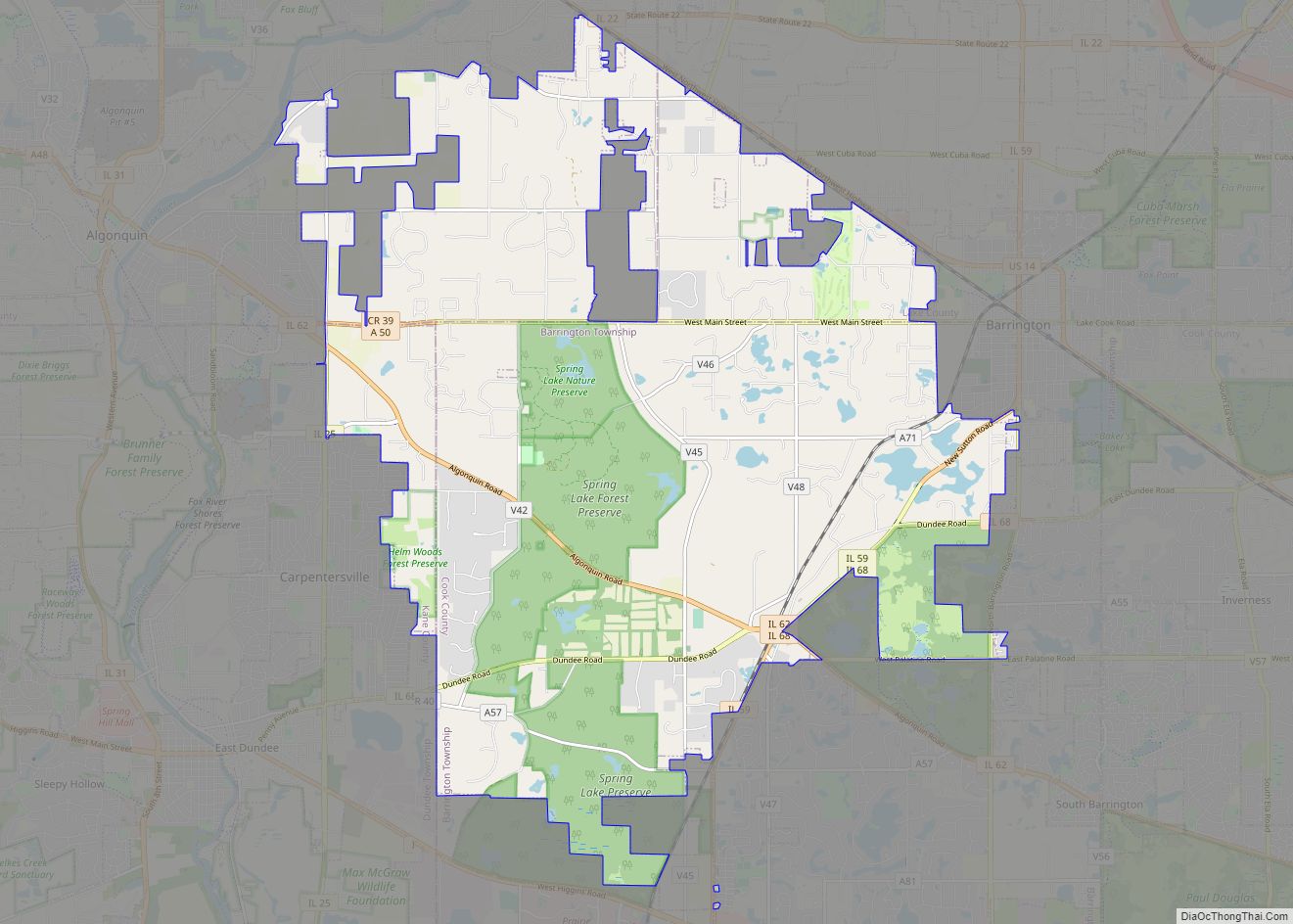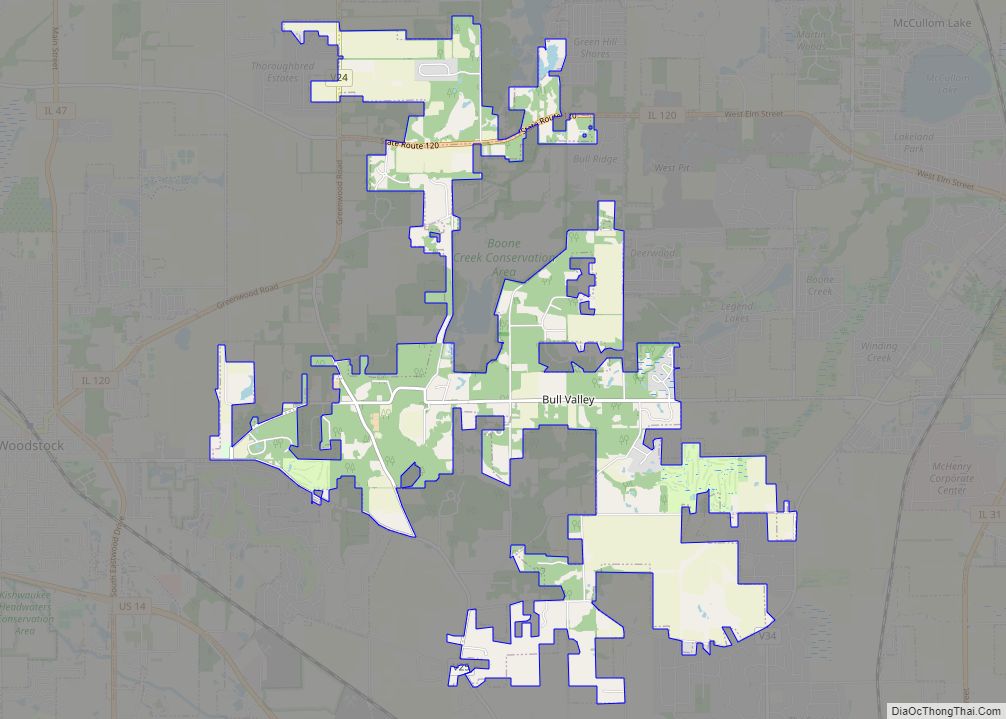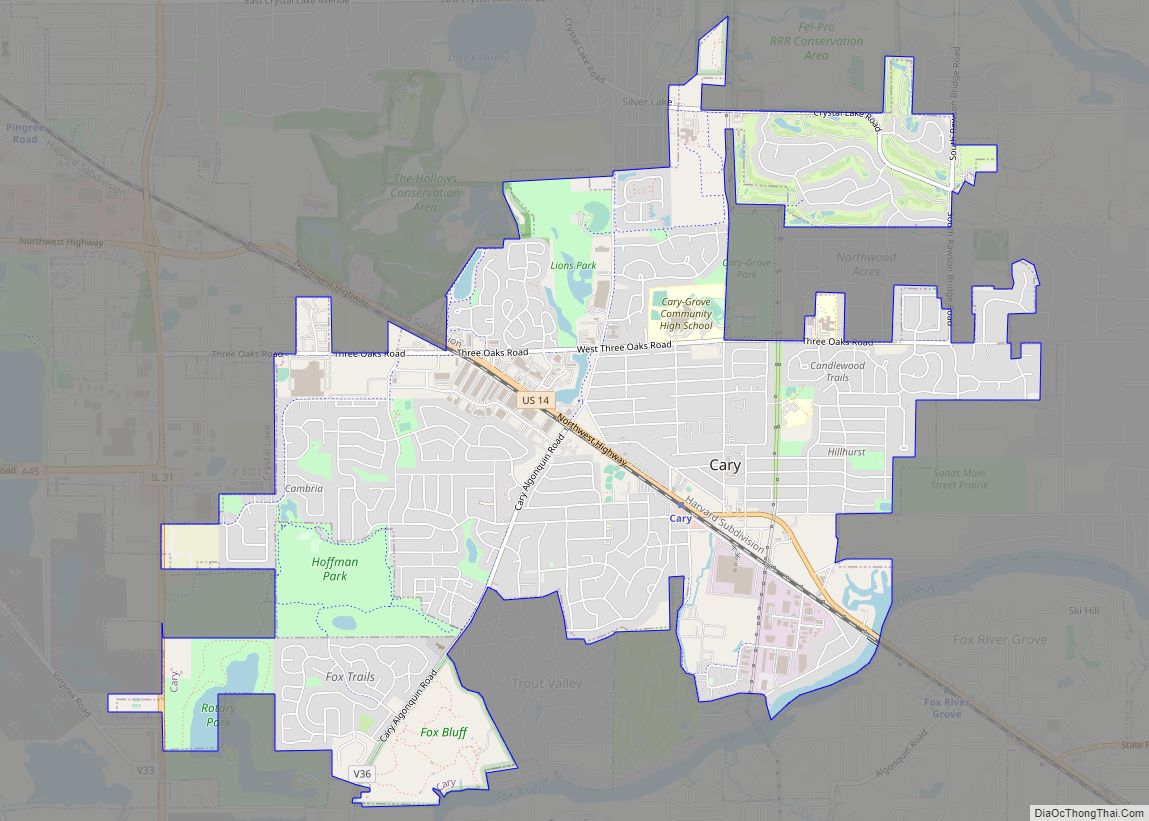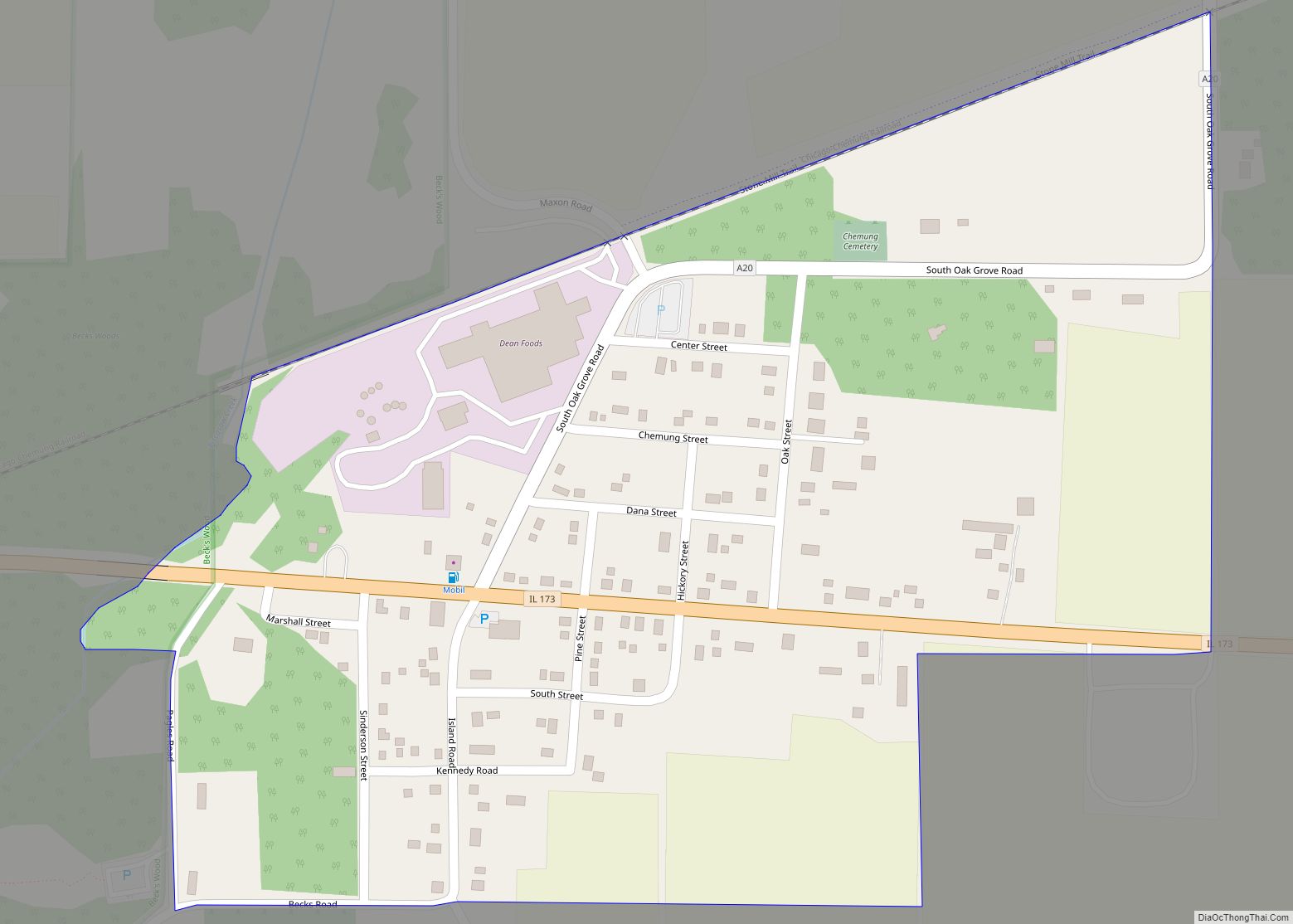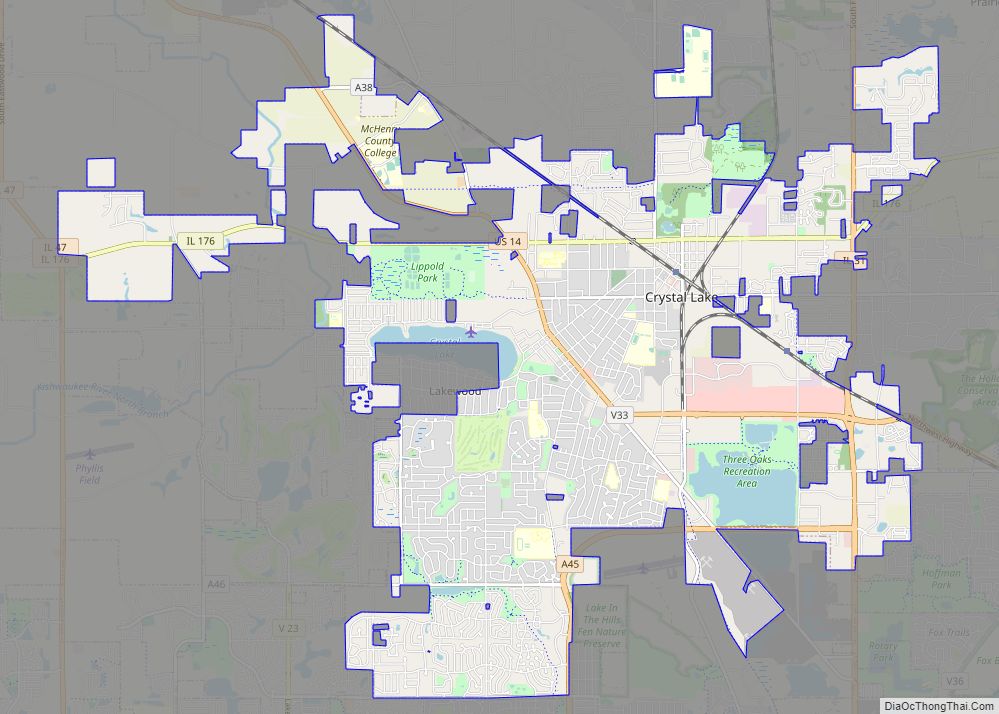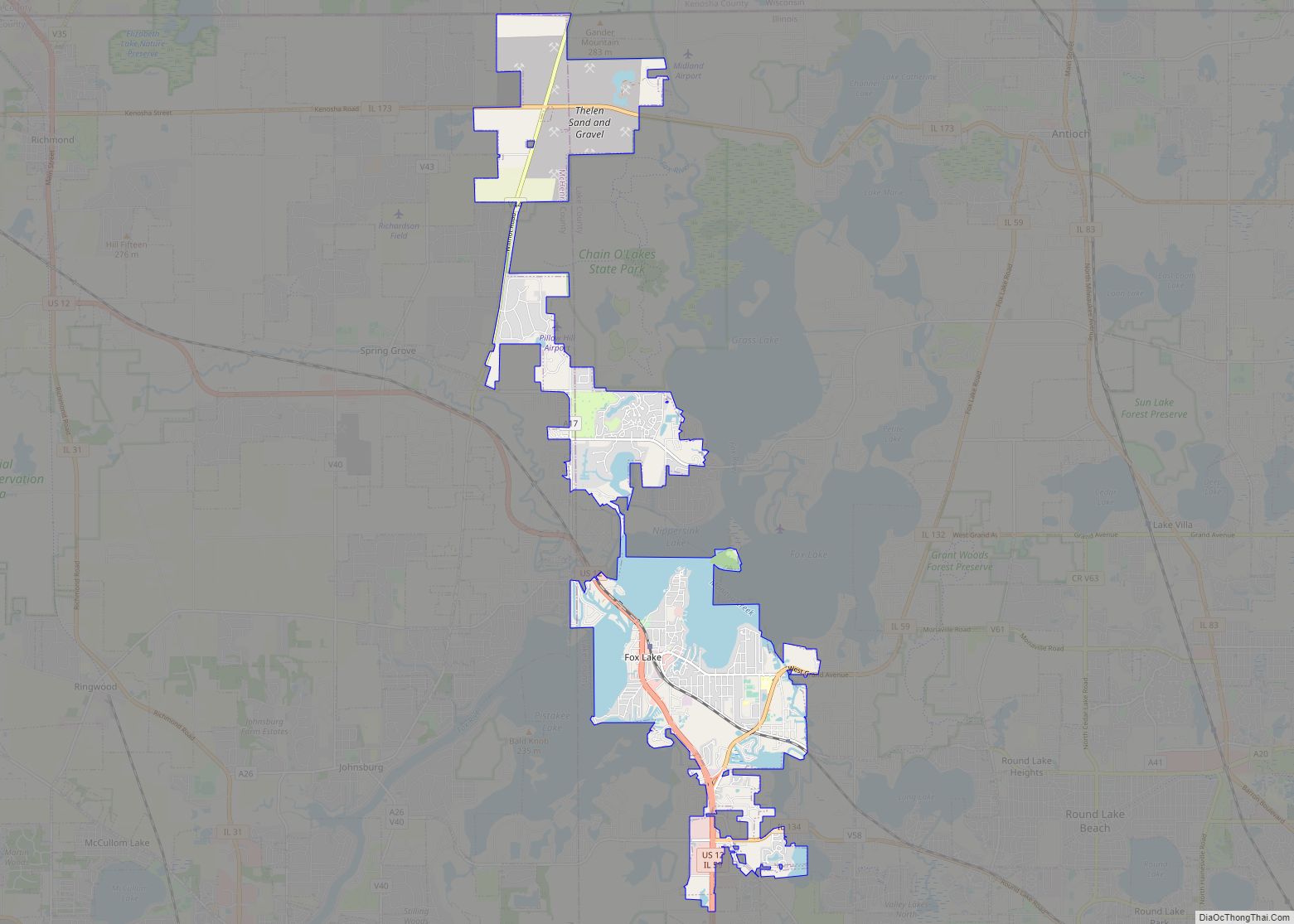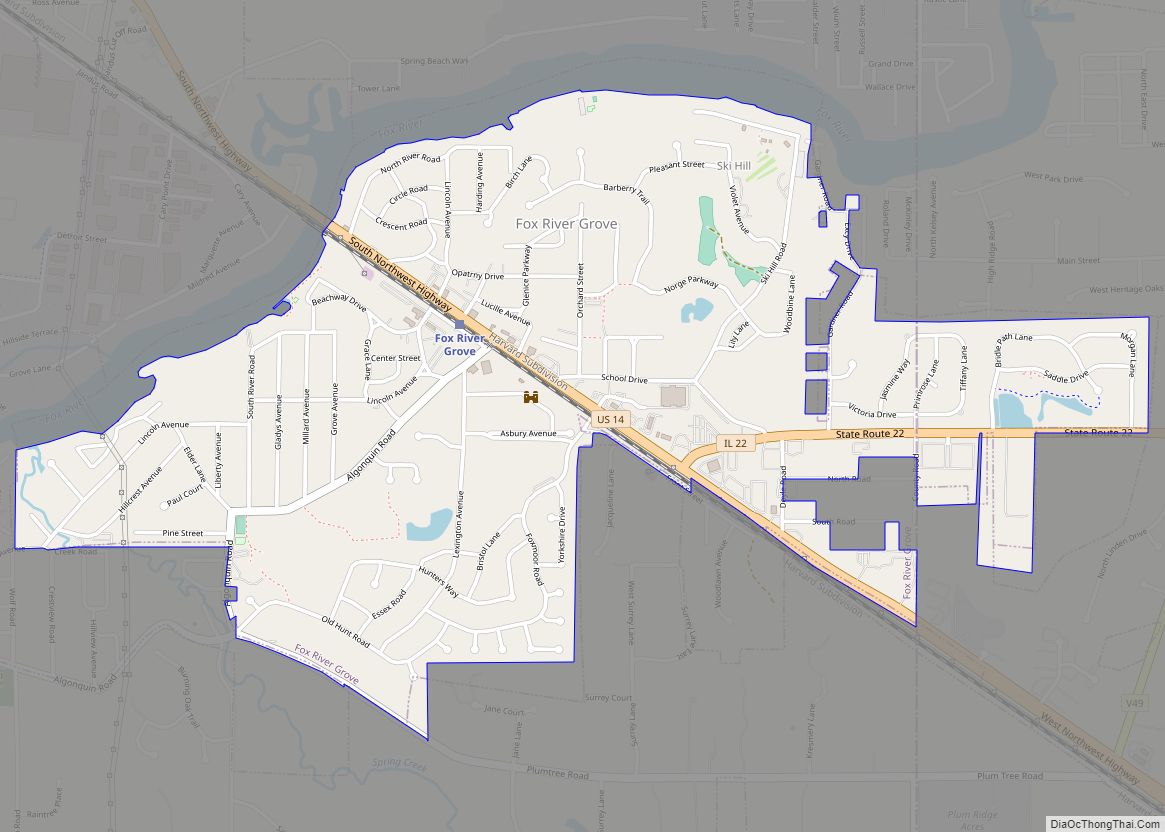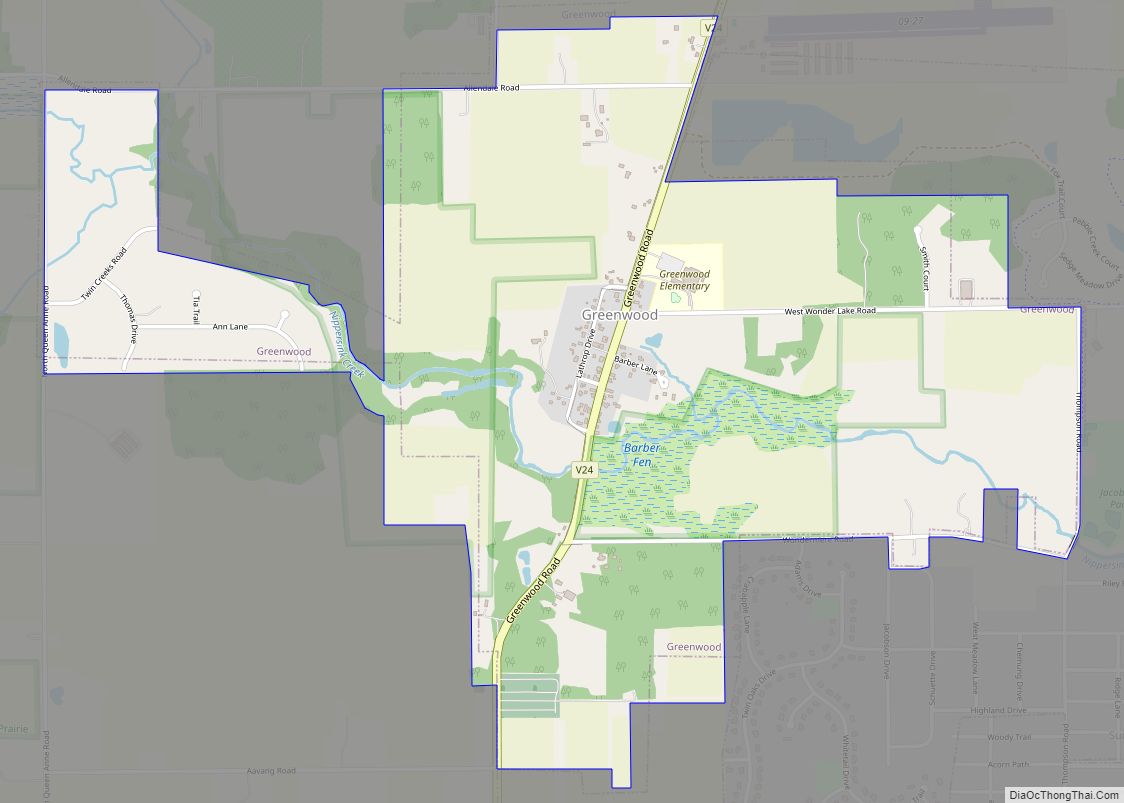Crystal Lake is a city in McHenry County in the U.S. state of Illinois. Named after a lake 1.6 miles (2.6 km) southwest of the city’s downtown, Crystal Lake is 45 miles northwest of Chicago. The population is 40,269 as of the 2020 Census, a 1.2% decrease from 2010. Crystal Lake is the largest city in McHenry County, part of the Chicago metropolitan area.
| Name: | Crystal Lake city |
|---|---|
| LSAD Code: | 25 |
| LSAD Description: | city (suffix) |
| State: | Illinois |
| County: | McHenry County |
| Elevation: | 942 ft (287 m) |
| Total Area: | 19.53 sq mi (50.59 km²) |
| Land Area: | 18.92 sq mi (49.00 km²) |
| Water Area: | 0.61 sq mi (1.59 km²) |
| Total Population: | 40,269 |
| Population Density: | 2,128.61/sq mi (821.87/km²) |
| FIPS code: | 1717887 |
| Website: | www.crystallake.org |
Online Interactive Map
Click on ![]() to view map in "full screen" mode.
to view map in "full screen" mode.
Crystal Lake location map. Where is Crystal Lake city?
History
Founding
The City of Crystal Lake traces its origin to two separate communities which were established in the 1800s. Those communities were generally known as Nunda and Crystal Lake. In 1835, Ziba S. Beardsley had come to the shores of the lake and commented that the “waters were as clear as crystal”, thereby giving the lake its name. Ziba Beardsley continued south to Naperville. In February 1836, the first white settlers, Beman and Polly Crandall and six of their ten children, came from New York State traveling to Crystal Lake in a covered wagon. Their original cabin was built in the vicinity of today’s intersection of Virginia Street and Van Buren Street. Four of the Crandall children were born there. Najah Beardsley’s family was the second to settle in the area; his grandson, William Beardsley, was the first white child born on the Crystal Lake prairie, on May 7, 1837.
The town was first known as Crystal Ville. It was changed to Crystal Lake sometime before 1840. The area known today as downtown Crystal Lake was first called Dearborn and later, Nunda (pronounced locally as “Nun-day”), from an area in New York where many settlers originated. The village of Dearborn was founded in the 1850s after an extension of railroads through the area. The first train station was built in 1856, although it was pre-fabricated and shipped from Chicago on a flatcar. At that time, the main business district for the village of Crystal Lake was located on Virginia Street, about one mile (1.6 km) southwest of the railroad station. The railroad served to connect both the people and industries of Crystal Lake and Dearborn to Chicago and the rest of the country. Dearborn grew quickly due to this new rail connection.
On October 7, 1868, Dearborn’s name was changed to Nunda. The village was platted in 1868 by local surveyor, John Brink, after whom a downtown street is now named. The village included the area now generally bounded by Illinois Route 176 on the north, Crystal Lake Avenue on the south, Main Street on the east, and Walkup Avenue on the west. Much of the land was originally owned by two early settlers, Daniel Ellsworth and Simon S. Gates. The villages of Crystal Lake and Nunda were both incorporated in 1874. In 1908, the name of the village of Nunda changed its name to North Crystal Lake. Several attempts were made to consolidate the two villages, and finally, after much disagreement, the village of North Crystal Lake was annexed to the Village of Crystal Lake in 1914, and a consolidated city government was established.
Dole family
Back in the 1860s, when the town of Crystal Lake was about 25 years old, Charles S. Dole purchased over 1,000 acres (4.0 km) of land overlooking the lake. It was his dream to construct an elaborate estate that would reflect his position as a successful businessman. He was an early member of the Chicago Board of Trade, being associated with Armour, Dole & Co. in Chicago. To carry out his plan, he built a three-story mansion with adjoining gardens and stables. European craftsmen were imported to lay parquet floors, fashion archways and carve interior wood work from black walnut trees grown on the property. As a final touch, he brought in Italian artisans to build several marble fireplaces. According to Mr. Dole’s obituary, construction costs exceeded $100,000, an enormous amount of money in those days.
The estate was known as Lakeland Farm. Mr. Dole lived there with his wife Julia, his mother-in-law, Mrs. Harriet Coffin, his two daughters, Mary Florence, Harriet (Hattie), and son, Sydney. Dole maintained the estate for over 30 years, entertaining lavishly. As an example, for his daughter’s wedding in 1883 he built a spur line from the Chicago and Northwestern railway tracks almost to his doorstep. A canopied and carpeted walkway extended 750 feet (230 m) from the front door to the train enabling the guests to walk to the mansion for the ceremony and return to the train without concern for the weather. Notable wedding guests included Julian Rumsey (mayor of Chicago and Dole’s first cousin) and Levi Leiter (first partner with Marshall Field).
Mr. Dole’s interests changed throughout the years. He laid out a half-mile racetrack on his property and purchased the finest horses that money could buy, soon accumulating a string of horses that was the envy of northern Illinois. It is said that Dole loved to go up in his tower (currently closed off) and watch his horses run. When tired of the fad of his stable, he disposed of his horses by holding an elaborate sale. The Doles lived in the mansion until the late 1890s when the property was sold to his son-in-law for $1.00.
During the early 1900s, the property was owned and operated by several different ice companies. Ice was harvested from Crystal Lake and shipped by rail to nearby Chicago. The advent of refrigeration brought about the decline of the ice business. After laying vacant for several years, the property was sold in 1922 to the Lake Development Company. The building was purchased by the First Congregational Church of Crystal Lake in 1977. The annex portion of the structure was renovated by thousands of hours of volunteer work. The Church named the facility “Lakeside Center” and operated it as a community activities center, hosting Friendship House Day Care Center for children, church offices, meeting rooms, reception hall, and retreat facilities. Today the Dole Mansion is owned by the Lakeside Legacy, along with Lakeside center, which is the building connected to the Dole Mansion. Dole Mansion is located along the lake, and there is a festival held on the grounds every year.
Eliza Ringling
Ringling Road is an east-west road which curves from Country Club Road back up to Lake Avenue. There are less than one dozen houses that claim a Ringling Road address; but those houses range from a small, stone cottage to large, imposing mansions. It is no mistake that Ringling Road provides the northern boundary for the Dole Mansion property. The road was named after Eliza “Lou” Ringling who, as founder of the Lake Development Company, purchased the Dole Mansion in 1922 and converted it into the first Crystal Lake Country Club. The transaction involved nearly a half million dollars and was one of the largest real estate deals handled in the area. The original Crystal Lake Country Club faltered in the stock market crash of 1929, and Mrs. Ringling, with her group of investors (the Lake Development Company) subdivided much of the large Dole estate into what is known as the Country Club Additions subdivision parts of which are in the neighboring village Lakewood, Illinois.
Eliza “Lou” Ringling was the widow of the oldest Ringling brother, Albert, of circus fame.
Teco pottery
The American Terra Cotta Tile and Ceramic Company was founded in 1881 just north of Crystal Lake, Illinois. Most of the workers at the tile and ceramic works factory came from Crystal Lake, The production consisted of drain tile, brick and architectural items. In 1886 the Gates Pottery was established as a subsidiary with William D. Gates, a Crystal Lake area native as its president. The company fabricated architectural glazed terra cotta that was used on buildings designed by architects Louis Sullivan and Frank Lloyd Wright in the style of the Prairie School. American Terra Cotta’s company records show that architectural glazed terra cotta was used on many local buildings including Oak Manufacturing Company, Teckler Building, Cohn Store, Telephone Exchange and Commercial Building, El-Tovar Theatre, Crystal Lake High School and additions, Central School and additions, Pure Oil Research Lab and additions, Sinclair Refining Company Service Station, Warner Building, Citizens State Bank, Garbe Garage, Home State Bank, various Williams Street stores and bakeries, and Martinetti’s Motel.
Gates used the facilities to experiment with clays and glazes in an effort to design a line of art pottery which led to the introduction of Teco pottery (from TErra COtta, but pronounced locally as “Tea-co”) in 1902. Many of the pottery pieces were designed by architects such as Frank Lloyd Wright Produced for only a few years, this pottery exemplifies the Arts and Crafts Movement and today is highly sought after by art collectors. Teco pottery is in the collection of many museums.
Recent history
On April 11, 1965, during the Palm Sunday tornado outbreak, a large and devastating tornado damaged or destroyed large portions of the city. Six people were killed by the tornado, and a further 75 wounded. Damages in the city totaled over $1.5 million, as 80 homes and a shopping center were completely destroyed. Disaster shelters were set up to house the homeless, and then-governor of Illinois, Otto Kerner, Jr., personally visited the city to view the damage.
In the past 20 years, the history of Crystal Lake has consisted mainly of the growing of suburban subdivisions, as the population increased to 38,000 in the 2000 Census from 21,823 in the 1990 Census. In order to deal with the growth, Crystal Lake South High School was opened in 1978. Previously, Crystal Lake Community High School (now Crystal Lake Central High School) had served the entire city of Crystal Lake since 1924. Even more recently a third high school, Prairie Ridge High School, opened in 1997 north of the city to accommodate the spread moving into the area between Crystal Lake and the two communities directly to its north, Prairie Grove and Bull Valley.
Some challenges currently facing the city of Crystal Lake include a large and sudden increase in immigration, and an inconvenient road system leading to frequently snarled traffic. However, the overall quality of life and education in the city remains quite high. In addition, a robust city park system and continued revitalization of the downtown area, including a new city hall, have continued to make Crystal Lake an attractive community for new residents. Another positive note for the city is that Crystal Lake is the city where the tradition of giving gold coins to the Salvation Army anonymously began in 1982.
Aaron T. Shepley was the mayor of Crystal Lake from 1999 to his death in 2020, making him the longest-serving mayor in the city’s history.
The Raue Center for the Arts, in the downtown district, has distinguished itself as a regional and national tourism draw. The National Piano Conference has been held in the Raue Center since 2012.
In 2015, Crystal Lake was ranked tenth best city among 1,268 U.S. cities with populations between 25,000 and 100,000 by WalletHub.
In 2016, it was reported that there were zero retail vacancies in the downtown district of Crystal Lake. This was the case until 2017.
On July 7, 2021, U.S. President Joe Biden visited McHenry County College in Crystal Lake, becoming the first sitting president to visit the city. Then-Vice President George H. W. Bush had twice visited Crystal Lake in 1988 while campaigning for president.
Crystal Lake Road Map
Crystal Lake city Satellite Map
Geography
According to the 2010 census, Crystal Lake has a total area of 18.957 square miles (49.10 km), of which 18.35 square miles (47.53 km) (or 96.8%) is land and 0.607 square miles (1.57 km) (or 3.2%) is water.
See also
Map of Illinois State and its subdivision:- Adams
- Alexander
- Bond
- Boone
- Brown
- Bureau
- Calhoun
- Carroll
- Cass
- Champaign
- Christian
- Clark
- Clay
- Clinton
- Coles
- Cook
- Crawford
- Cumberland
- De Kalb
- De Witt
- Douglas
- Dupage
- Edgar
- Edwards
- Effingham
- Fayette
- Ford
- Franklin
- Fulton
- Gallatin
- Greene
- Grundy
- Hamilton
- Hancock
- Hardin
- Henderson
- Henry
- Iroquois
- Jackson
- Jasper
- Jefferson
- Jersey
- Jo Daviess
- Johnson
- Kane
- Kankakee
- Kendall
- Knox
- La Salle
- Lake
- Lake Michigan
- Lawrence
- Lee
- Livingston
- Logan
- Macon
- Macoupin
- Madison
- Marion
- Marshall
- Mason
- Massac
- McDonough
- McHenry
- McLean
- Menard
- Mercer
- Monroe
- Montgomery
- Morgan
- Moultrie
- Ogle
- Peoria
- Perry
- Piatt
- Pike
- Pope
- Pulaski
- Putnam
- Randolph
- Richland
- Rock Island
- Saint Clair
- Saline
- Sangamon
- Schuyler
- Scott
- Shelby
- Stark
- Stephenson
- Tazewell
- Union
- Vermilion
- Wabash
- Warren
- Washington
- Wayne
- White
- Whiteside
- Will
- Williamson
- Winnebago
- Woodford
- Alabama
- Alaska
- Arizona
- Arkansas
- California
- Colorado
- Connecticut
- Delaware
- District of Columbia
- Florida
- Georgia
- Hawaii
- Idaho
- Illinois
- Indiana
- Iowa
- Kansas
- Kentucky
- Louisiana
- Maine
- Maryland
- Massachusetts
- Michigan
- Minnesota
- Mississippi
- Missouri
- Montana
- Nebraska
- Nevada
- New Hampshire
- New Jersey
- New Mexico
- New York
- North Carolina
- North Dakota
- Ohio
- Oklahoma
- Oregon
- Pennsylvania
- Rhode Island
- South Carolina
- South Dakota
- Tennessee
- Texas
- Utah
- Vermont
- Virginia
- Washington
- West Virginia
- Wisconsin
- Wyoming
